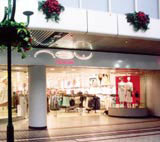In with the new

Value retailing is no longer deemed a case of cheap and cheerful; fashion chain New Look is attempting to live up to its name, as Richard Clayton finds out
New Look’s London offices back on to a particularly insalubrious stretch of Oxford Street. Approaching them via what managing director Phil Wrigley unaffectionately calls ‘rat alley’, it is not hard to see why the company’s headquarters are hidden away in Weymouth, Dorset. But appearances often mislead – this is one value retailer planning an altogether ritzier entrance to the capital.
Later this summer, New Look opens a 1600m2 flagship store at 500 Oxford Street, designed by architect Future Systems (DW 6 February). Yes, the same Future Systems responsible for Selfridges’ keenly awaited Birmingham satellite, described as a ‘curvaceous caterpillar’ by architectural critic Deyan Sudjic, and the Moonbase Alpha-style media centre at Lord’s cricket ground in London. While New Look’s name may be rather ‘does-what-it-says-on-the-tin’, the brand is developing a taste for the unconventional that belies its pile-’em-high heritage.
Alongside the Future Systems commission, New Look has revamped its identity – with design work by Southampton-based Tandem – for the first time in almost 30 years (DW 6 February). An estate refurbishment programme is underway. Project Heartland is concerned with relocating to 160 larger stores – around 370-740m2 – to grow profit in city centres and market towns. Project 300 is about refreshing the formats of 300 or so smaller outlets. Initial design concepts for the former were laid down by Brinkworth.
As Wrigley well knows, value clothing retailers are under pressure to improve their offers. The sector outperformed the high street boom by 14 per cent in 2001. But now the squeeze is on. Discounting further is unsustainable as it damages margins. Matalan, the leading performer according to Verdict’s most recent figures (which put New Look in third place), is facing an identity crisis about whether it should stick or twist. Internal squabbles and management departures have resulted. For Wrigley, however, the only way is up.
‘Customers in our [segment] have a right to expect it all,’ he says. ‘Great fashion, great prices and an inspirational store environment.’
This is partly in response to new entrants like Zara – ‘a fabulous competitor and benchmark,’ Wrigley observes – and partly because consumers are so conscious of what they value for their money. ‘Fast fashion’ is how Wrigley describes his business. The definition encompasses not just the speed of turnaround from catwalk to high street – though New Look has worked with cutting edge British designer Luella Bartley – but also the dynamism of what he calls the ‘pick up and pay philosophy’.
‘That’s all design,’ Wrigley says, referring to the supply chain ‘in its broadest sense’, from the aesthetic appeal of products to the practicalities of getting them on and off the peg. ‘I’ve done jobs through buying and merchandising, finance, logistics and marketing. That’s what I enjoy best as managing director, having that collective responsibility – it gives me a little knowledge about a lot of things and a healthy respect for specialists in certain fields.’
Having graphic designers as parents probably helps Wrigley’s sense of perspective here. But his line in humorous self-awareness is all his own. Proportioned in a John Thomson-fromCold Feet sort of way, he says it is tricky to find a suit ‘that fits my extraordinary body’ and calls his managerial skills ‘classic mongrel’.
As the brand evolves, ‘differentiating without alienating’ is Wrigley’s touchstone. As a business, however, New Look is not afraid to show its teeth. Last month, chief executive Stephen Sunnocks announced 60 people in Weymouth would be losing their jobs. The boldness of New Look’s consumer ambitions is matched by a ruthless streamlining of costs.
The approach is producing dividends. Although New Look’s trading statement, published last week, showed sales have fallen back in the first three months of this year, this is against a background of general war anxiety, which has affected all retailers, and an impressive record of growth before that. Indeed, since 2000, Sunnocks and his team have overhauled New Look’s performance. It had been something of a laughing stock after previous boss Jim Hodkinson left under the cloud of sexual harassment allegations.
New product categories are being intensively researched. Wrigley has been ‘studying blokes and their lives’ for the past ten months. ‘I believe we can do a job on fashion value for men like we do for female customers. But we have to be aware that men’s expectation of the retail environment and shopping experience is different.’
Many of the changes to New Look’s store layouts, particularly the fitting rooms, aim to provide ‘inclusive central areas’ where girlfriends can try on clothes together, away from waiting boyfriends and the hoi polloi. Retail strategy must involve a lot of family psychology these days. Wrigley also talks of ‘sibling rivalry’ in positioning the teenage range 915, and finding ‘something for Mum as well’.
So, what does Wrigley do when not commuting between London, Dorset and his home near Oxford? Well, he is concerned with the grass in his 3ha paddock. ‘Sadly, agriculture seems to have virtually disappeared and you can’t get any sheep to keep the stuff down,’ he says. ‘Ah’, I reply lamely, ‘you can’t get the sheep’. Not exactly, Wrigley interjects.
‘The only sheep we’ve got are three stainless steel ones – we got them from blacksmith who was presenting product at the Chelsea Flower Show.’ Right, of course. Wrigley’s ‘stupid sense of humour’ should stand him in good stead when people come to nickname his Future Systems creation.
Phil Wrigley’s CV
October 2000 becomes New Look managing director
1999-2000 buying and merchandising director at BHS
1998-1999 operations director at BHS
1993-1998 retail operations director at Dorothy Perkins
1983-1993 various roles at Debenhams, culminating in finance director
1978-1983 management consultant, Ernst & Young
-
Post a comment



